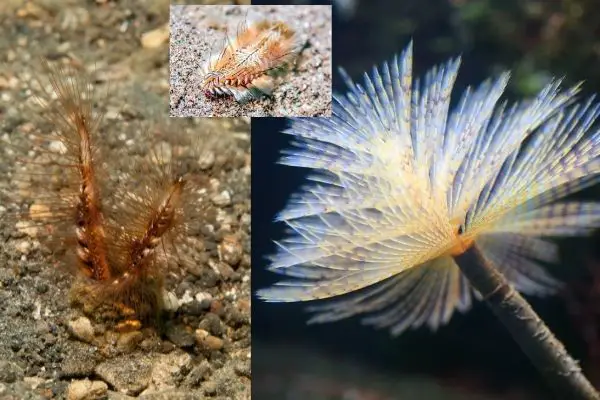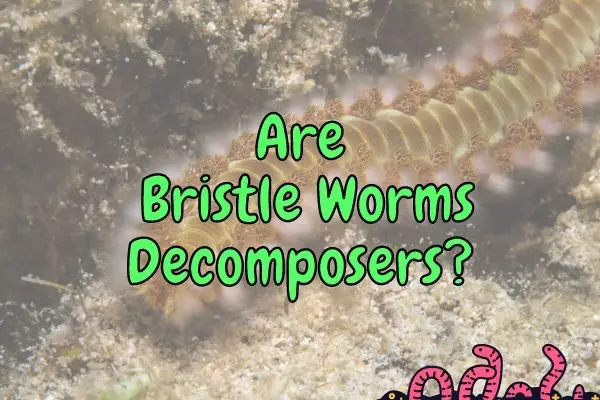Bristle worms are common invertebrates that live in everything from saltwater aquariums to soil and wood. They get their name from the bristles that cover their bodies and help them to eat, feel, and move.
Bristle worms are indeed decomposers that function as detritivores and scavengers. Bristle worms are a diverse group of organisms. While some of the bigger species are predatory carnivores, most of them are opportunistic detritivores that feed on algae, detritus, plankton, carrion, and dead plant matter.
They play an important role in the decomposition of these materials, which helps to recycle nutrients back into the soil.
However, their diet changes as different food types become more abundant or as they grow bigger and can handle larger food items. For example, larger bristle worms are more likely to be predatory than smaller ones1.
The ‘bristles’ that give them their name serve three purposes: They detect small food particles, they enable the worms to walk, swim and burrow, and they protect the worms against predators.
Fireworms, a type of bristle worm, have sharp spikes that can break off and release poison. They use their bristles to ward off predators, and to capture prey.
Contents
What are bristle worms and where do they live?
Bristle worms are a relatively large group, with about 10,000 species having been described. They appear first in the fossil record in the Cambrian, but were very abundant in the Jurassic and Cretaceous periods compared to now.
They range from the large and conspicuous polychaete worms, which live in most marine environments and can reach almost 2 meters in length, to the small and often transparent marine nematodes less than 1mm in length!
In aquariums, bristle worms help to clean up excess food and waste. In nature, they can be found in freshwater lakes and streams, marine environments, and on land in moist soil or leaf litter, where they play a similar role.

Some bristle worms are well-known as invasive species, such as the many species brought to the Hawaiian Islands as ‘pets’ or for fishing, which have caused significant environmental damage.
Why are Bristle Worms Important for the Ecosystem?
Bristle worms are also a very diverse group of organisms that live and feed on decaying organic matter.
Therefore bristle worms are important in many ecosystems because they help to break down dead and decaying matter, which recycles nutrients back into the environment like the water or soil where they reside.
This process is important for plant growth and helps to keep the environment clean. They also provide a food source for other animals in the ecosystem.
Where are Bristle Worms in the Food Chain?
As detritivores and predators, bristle worms have a complicated place in the food chain. A food chain is a linear structure indicating the direction of energy flow in an ecosystem.
Producers, plants in terrestrial ecosystems and bacteria and algae in aquatic ecosystems, make up the bottom of the food chain since they produce energy directly from the environment and not from another organism.
Primary consumers, or herbivores, are next in line, and they feed on the producers.
When bristle worms feed on plant debris, or algae, they are primary consumers. When they feed on carrion or predate on live animals, however, they are secondary consumers or carnivores, which feed on other consumers.
Are Bristle Worms Carnivores, Herbivores or Omnivores?
As opportunistic feeders, most bristle worms are omnivores because they eat both plant, and animal matter. However, some bigger species or individuals can be carnivorous.
Fireworms are an example of a predatory bristle worms that eat coral, invertebrates2 and small fish3.
It is important not to confuse bristle worms with caterpillars that may look alike in some aspects, but caterpillars are mostly herbivores that turn into butterflies!
Is a Bristle Worm a Producer, Consumer or Decomposer?
Bristle worms are consumers and decomposers. Consumers are animals that gain their energy from other organisms. Decomposers are a type of consumer that eat dead organisms.
In contrast, producers are organisms that gain their energy from their environment, for example from the sun, in the case of photosynthetic plants.
Since bristle worms cannot photosynthesize, they are not producers.
Are Bristle Worms Autotrophs or Heterotrophs?
Bristle worms are heterotrophs because they eat other living organisms. “Heterotroph” is just a fancy word for consumer and “autotroph” is a fancy word for producer.
Apart from plants, many bacteria are autotrophs, either because they can photosynthesize, or because they can use chemosynthesis to gain energy by breaking down inorganic chemicals.
Practically no animals are autotrophs because animals never developed a way to gain energy any other way than through eating other organisms.
Can Bristle Worms Be Considered Decomposers?
Bristle worms are a type of decomposer known as a detritivore. Detritivores eat dead plant and animal matter. True decomposers, however, are organisms such as bacteria and fungi, that break down dead organic matter into inorganic chemicals.
Interestingly, some of the decomposers doing the most work in ecosystems are the smallest ones – like the microscopic bristle worms shown in the video below:
Conclusion
In this blog post I have looked into the diet of bristle worms as an interesting and important group of decomposers that are found in our soils.
Bristle worms are an interesting group of animals that play an important role in the ecosystem. Not only do they eat a wide variety of food items, but they also provide a nutritious meal to many other animals in the sea.
If you would like to know more about the decomposers in your soil, check out my other blog posts on this subject.
References:
- Piesik Z, Obolewski K. 2007. Is the bristleworm Pygospio elegans Claparede (Spionidae) realy a deposit-feeder? Journal of Ecology and Protection of the Coastline. 11: 5-11.
- Lamar University. 2022. Marine Critters: Fireworm.
- First Time Fish Keeper. 2022. Critter identification: Fireworms.




